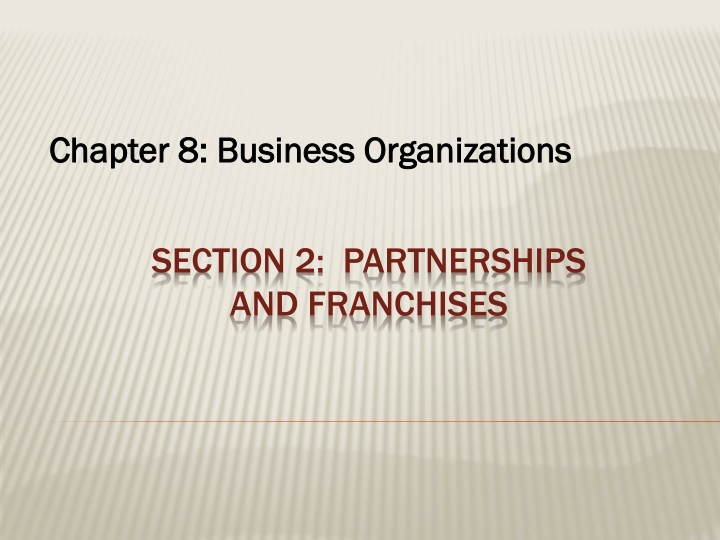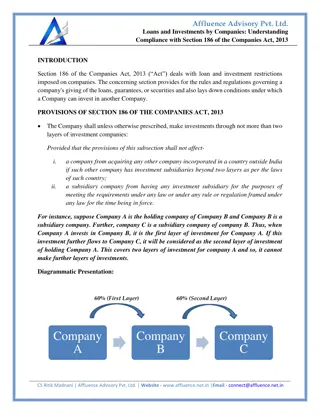
Business Organizations: Partnerships Overview
Learn about partnerships in business organizations - from general partnerships to limited partnerships. Understand the different characteristics, responsibilities, profits sharing, and liability aspects of each type. Discover the roles of partners, the concept of limited liability, and the nuances of control and profit sharing in partnerships.
Download Presentation

Please find below an Image/Link to download the presentation.
The content on the website is provided AS IS for your information and personal use only. It may not be sold, licensed, or shared on other websites without obtaining consent from the author. If you encounter any issues during the download, it is possible that the publisher has removed the file from their server.
You are allowed to download the files provided on this website for personal or commercial use, subject to the condition that they are used lawfully. All files are the property of their respective owners.
The content on the website is provided AS IS for your information and personal use only. It may not be sold, licensed, or shared on other websites without obtaining consent from the author.
E N D
Presentation Transcript
Chapter 8: Business Organizations Chapter 8: Business Organizations SECTION 2: PARTNERSHIPS AND FRANCHISES
PARTNERSHIPS A business organization that is A business organization that is Owned by two or more people Owned by two or more people Responsibilities are split Responsibilities are split Profits are split Profits are split
TYPES OF PARTNERSHIPS General Partnership General Partnership Most common type of partnership Most common type of partnership Characteristics Characteristics Share responsibilities equally Share responsibilities equally Share profits equally Share profits equally Share liability equally Share liability equally UNLIMITED, UNLIMITED, PERSONAL, PERSONAL, LIABILITY! LIABILITY!
TYPES OF PARTNERSHIPS Limited Partnership Limited Partnership Characteristics Characteristics Only one partner runs the business Only one partner runs the business Only one partner shoulders Only one partner shoulders UNLIMITED, UNLIMITED, PERSONAL, PERSONAL, LIABILITY! LIABILITY!
TYPES OF PARTNERSHIPS Limited partnerships Limited partnerships Characteristics Characteristics Second* partner s role Second* partner s role Contribute money Contribute money LIMITED liability LIMITED liability can only lose investment Collect share of profits Collect share of profits Second partner s limitations Second partner s limitations No say in how to run business No say in how to run business Silent Partner Silent Partner can only lose investment
TYPES OF PARTNERSHIPS Limited Partnership Limited Partnership Partners are not equal Partners are not equal One must be the general partner One must be the general partner Controls the company Controls the company UNLIMITED PERSONAL LIABILITY UNLIMITED PERSONAL LIABILITY Splits the profits Splits the profits Other partner(s) Other partner(s) Put up money Put up money Shares profits Shares profits Has NO SAY / NO CONTROL Has NO SAY / NO CONTROL
TYPES OF PARTNERSHIPS Limited Liability Partnerships Limited Liability Partnerships Similar to General Partnership Similar to General Partnership Partners are pretty much equal Partners are pretty much equal There is LIMITED liability There is LIMITED liability Only company assets are at risk Only company assets are at risk Only partner s assets are at risk if he or she makes the Only partner s assets are at risk if he or she makes the mistake mistake Only certain types of companies can be LLPs Only certain types of companies can be LLPs
PARTNERSHIPS Advantages Advantages Easy and inexpensive Easy and inexpensive to establish to establish Little government regulation Little government regulation More than one person contributes money and skills More than one person contributes money and skills Can offer more fringe benefits Can offer more fringe benefits Shared decision making Shared decision making
PARTNERSHIPS Disadvantages Disadvantages Potential conflict with partner(s) Potential conflict with partner(s) Unlimited liability (except LLPs) Unlimited liability (except LLPs) If your partner messes up and the company suffers, If your partner messes up and the company suffers, you suffer too! you suffer too! Lack of permanence Lack of permanence
PARTNERSHIPS YOUR TURN YOUR TURN: : 1. Which one of the three forms of partnerships 1. Which one of the three forms of partnerships do you think is best? do you think is best? 2. Why is it better than the 2. Why is it better than the other two forms? other two forms? (Give at least TWO good reasons.) (Give at least TWO good reasons.)
FRANCHISES SEMI SEMI- -independent business independent business Pays fees to parent company Pays fees to parent company Gets rights to open a store Gets rights to open a store in a certain area in a certain area
FRANCHISES Advantages Advantages 1. 1. Training and support from the parent company Training and support from the parent company 2. 2. Standardized quality requirements attract Standardized quality requirements attract customers customers 3. 3. Advertising benefits Advertising benefits 4. 4. Financial aid from parent company Financial aid from parent company 5. 5. Bulk buying benefits Bulk buying benefits
FRANCHISES Disadvantages Disadvantages 1. 1. Payments to mother company Payments to mother company Fees to start the business Fees to start the business A portion of the profits (royalties) A portion of the profits (royalties) 2. 2. Mother company sets strict standards Mother company sets strict standards 3. 3. You MUST purchase from mother company or from You MUST purchase from mother company or from approved markets approved markets 4. 4. Limited to selling only their products Limited to selling only their products a. a. b. b.
FRANCHISES YOUR TURN YOUR TURN: : You investigate the idea of opening your own You investigate the idea of opening your own franchise. (Sears Hardware Store?) franchise. (Sears Hardware Store?) 1.Which advantage(s) is/are most important to 1.Which advantage(s) is/are most important to consider? Why? consider? Why? 2.Which disadvantage(s) is/are most important to 2.Which disadvantage(s) is/are most important to consider? Why? consider? Why? 3.Do you do it? 3.Do you do it?






















